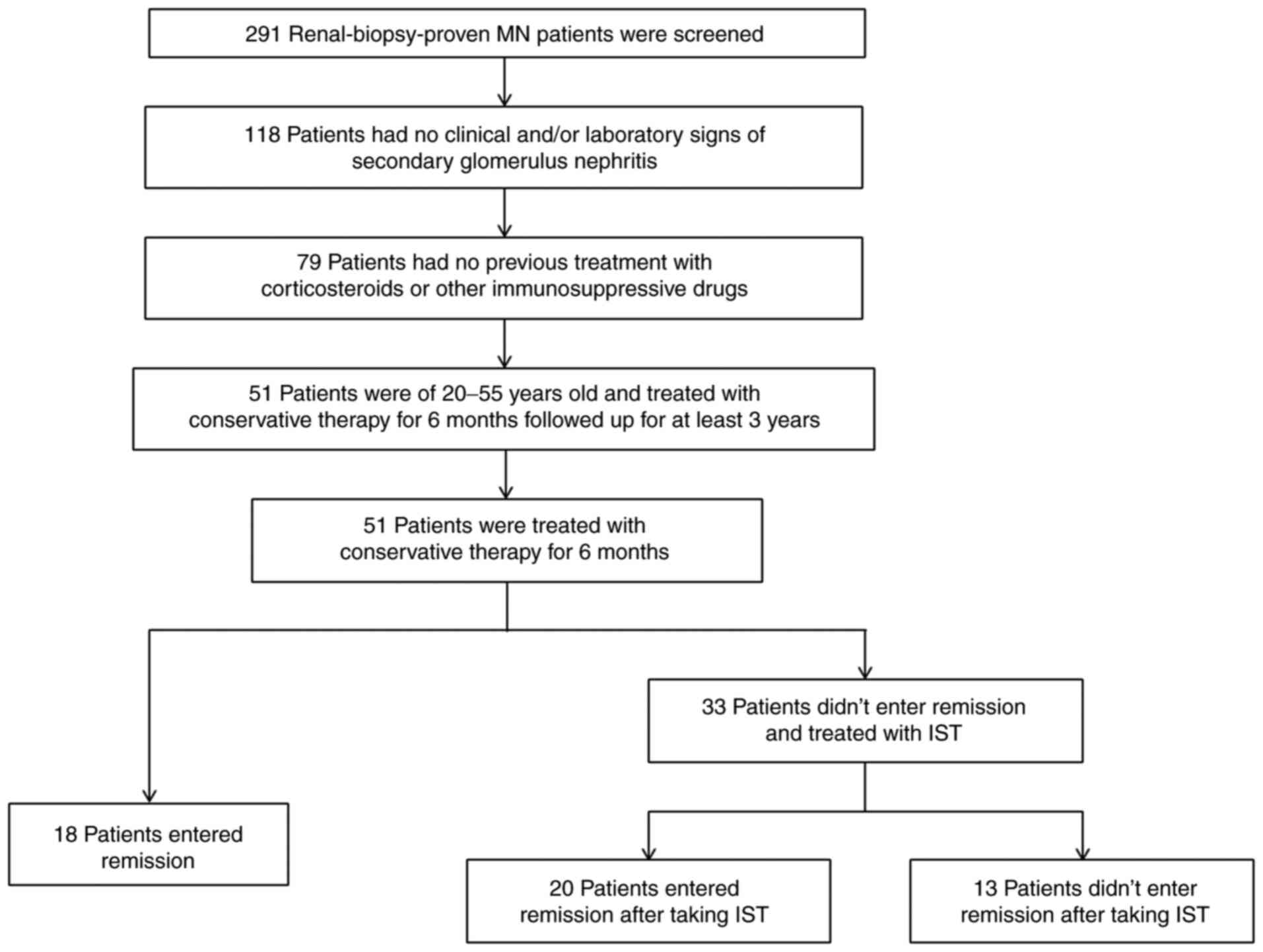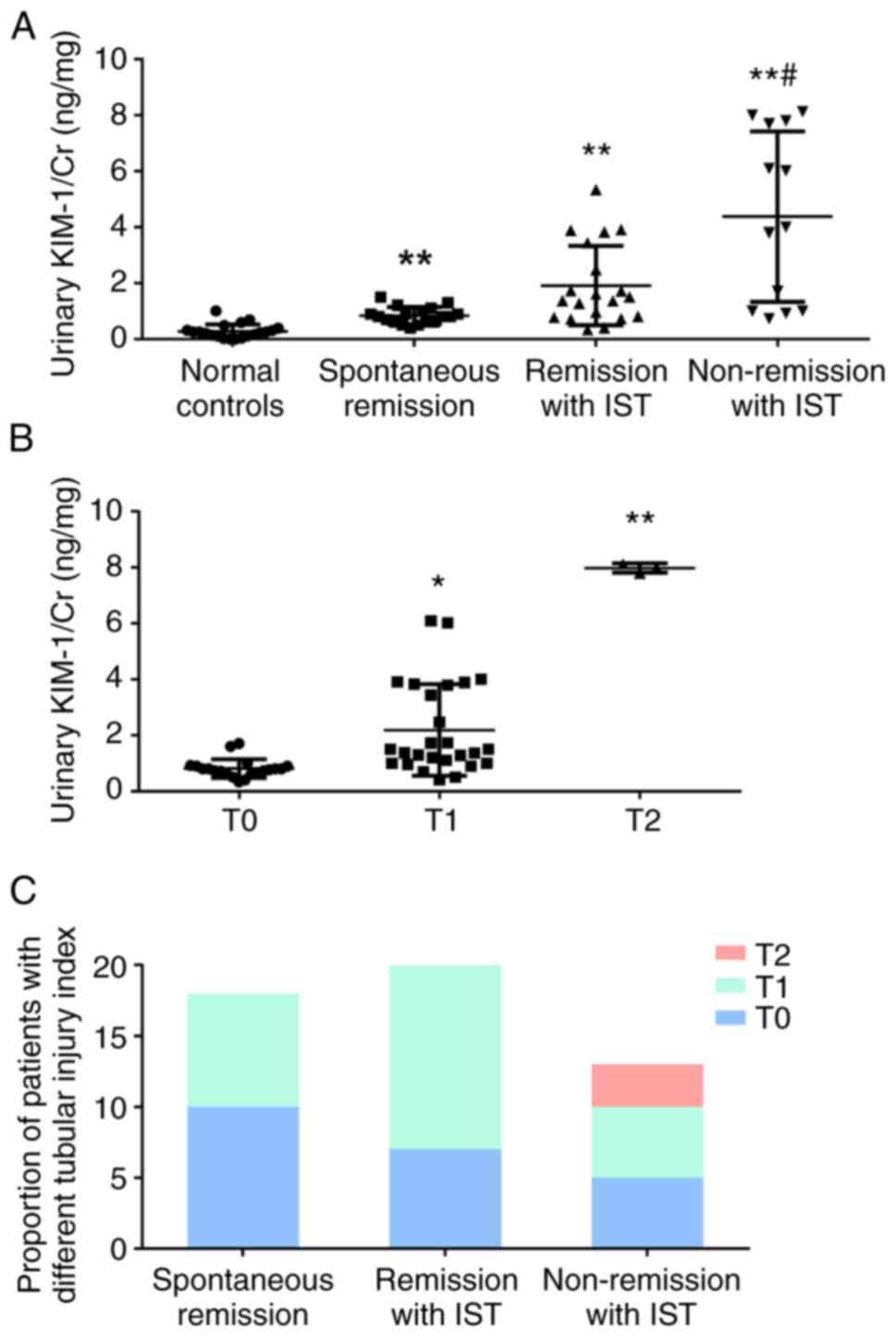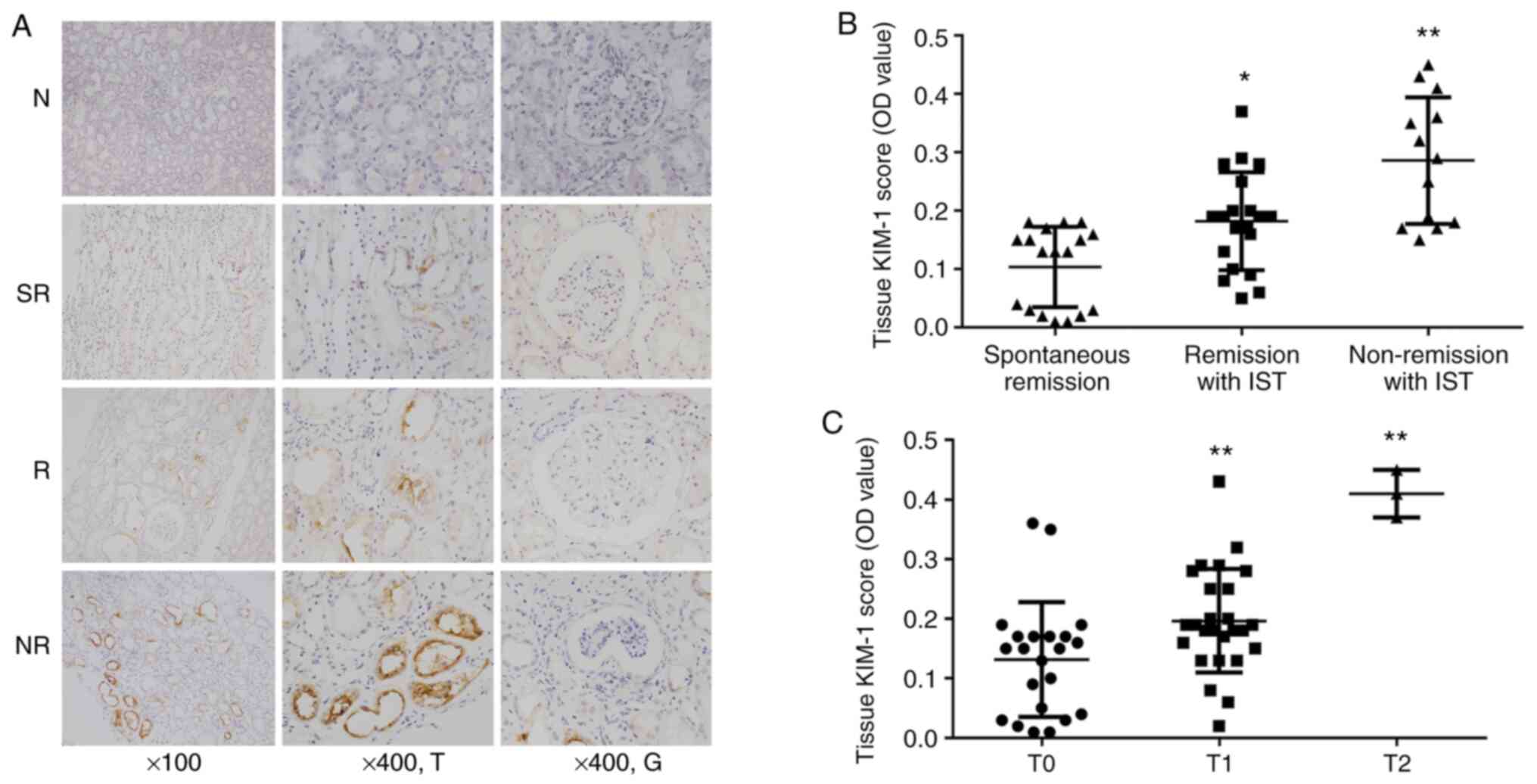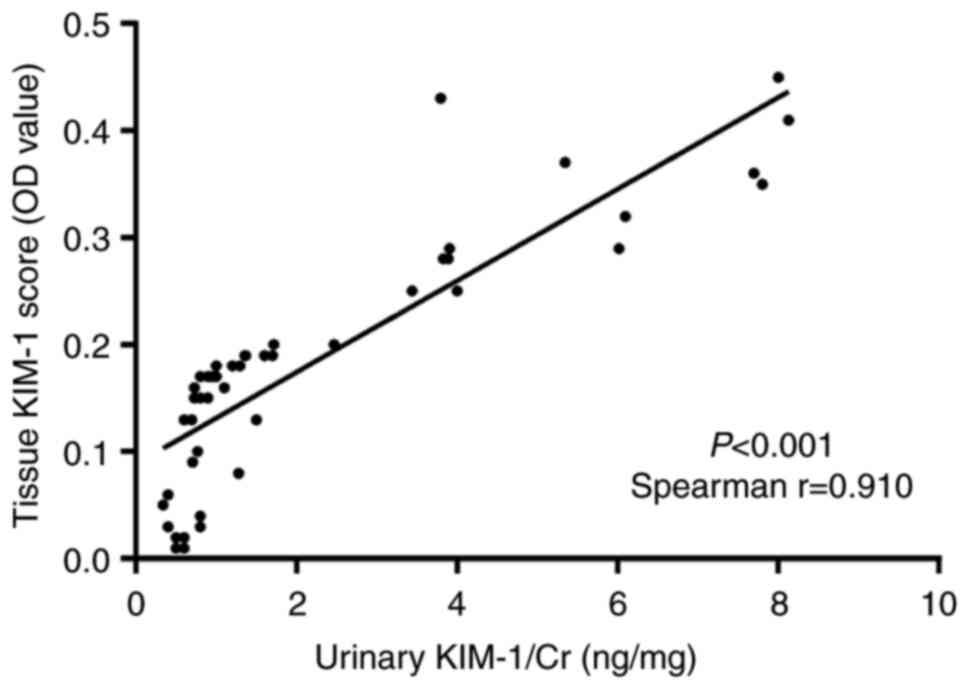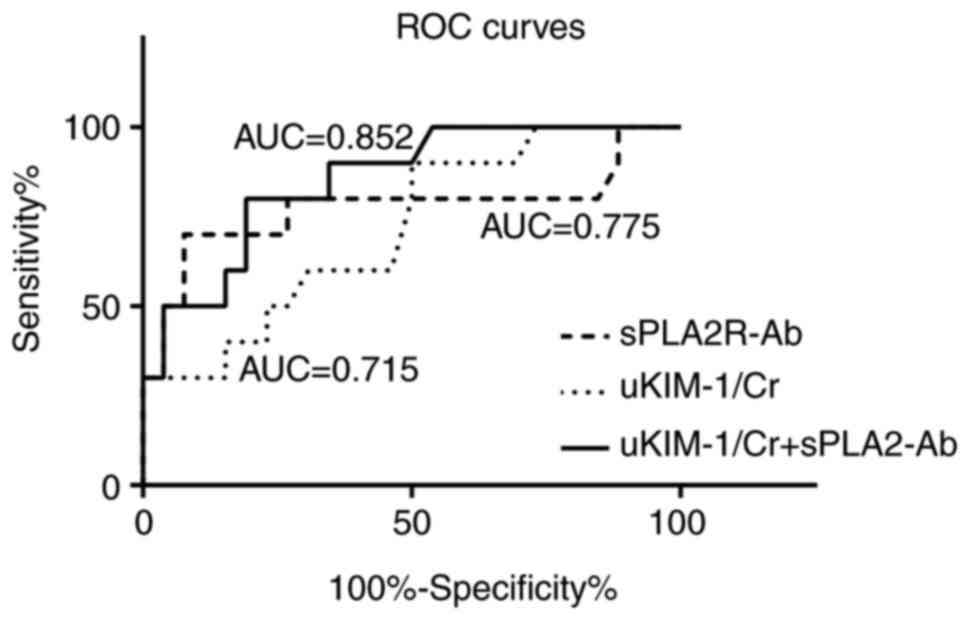|
1
|
Ronco P and Debiec H: Pathophysiological
advances in membranous nephropathy: Time for a shift in patient's
care. Lancet. 385:1983–1992. 2015.PubMed/NCBI View Article : Google Scholar
|
|
2
|
Hu R, Quan S, Wang Y, Wang Y, Zhou Y,
Zhang Y, Liu L, Zhou XJ and Xing G: Spectrum of biopsy proven renal
diseases in Central China: A 10-year retrospective study based on
34,630 cases. Sci Rep. 10(10994)2020.PubMed/NCBI View Article : Google Scholar
|
|
3
|
Beck LH Jr, Bonegio RG, Lambeau G, Beck
DM, Powell DW, Cummins TD, Klein JB and Salant DJ: M-type
phospholipase A2 receptor as target antigen in idiopathic
membranous nephropathy. N Engl J Med. 361:11–21. 2009.PubMed/NCBI View Article : Google Scholar
|
|
4
|
Timmermans SA, Hamid MA, Tervaert JW,
Damoiseaux JG and van Paassen P: Limburg Renal Registry. Anti-PLA2R
antibodies as a prognostic factor in PLA2R-related membranous
nephropathy. Am J Nephrol. 42:70–77. 2015.PubMed/NCBI View Article : Google Scholar
|
|
5
|
van de Logt AE, Hofstra JM and Wetzels JF:
Pharmacological treatment of primary membranous nephropathy in
2016. Expert Rev Clin Pharmacol. 9:1463–1478. 2016.PubMed/NCBI View Article : Google Scholar
|
|
6
|
Kidney Disease: Improving global outcomes.
KDIGO Clinical Practice Guideline for Glomerulonephritis. Kidney
International Supplements. 2(139)2012.
|
|
7
|
Polanco N, Gutierrez E, Covarsi A, Ariza
F, Carreño A, Vigil A, Baltar J, Fernández-Fresnedo G, Martín C,
Pons S, et al: Spontaneous remission of nephrotic syndrome in
idiopathic membranous nephropathy. J Am Society Nephrol.
21:697–704. 2010.PubMed/NCBI View Article : Google Scholar
|
|
8
|
Han WK, Bailly V, Abichandani R, Thadhani
R and Bonventre JV: Kidney injury molecule-1 (KIM-1): A novel
biomarker for human renal proximal tubule injury. Kidney Int.
62:237–244. 2002.PubMed/NCBI View Article : Google Scholar
|
|
9
|
Bonventre JV: Kidney injury molecule-1
(KIM-1): A urinary biomarker and much more. Nephrol Dial
Transplant. 24:3265–3268. 2009.PubMed/NCBI View Article : Google Scholar
|
|
10
|
van Timmeren MM, van den Heuvel MC, Bailly
V, Bakker SJ, van Goor H and Stegeman CA: Tubular kidney injury
molecule-1 (KIM-1) in human renal disease. J Pathol. 212:209–217.
2007.PubMed/NCBI View Article : Google Scholar
|
|
11
|
Waanders F, Vaidya VS, van Goor H,
Leuvenink H, Damman K, Hamming I, Bonventre JV, Vogt L and Navis G:
Effect of renin-angiotensin-aldosterone system inhibition, dietary
sodium restriction, and/or diuretics on urinary kidney injury
molecule 1 excretion in nondiabetic proteinuric kidney disease: A
post hoc analysis of a randomized controlled trial. Am J Kidney
Dis. 53:16–25. 2009.PubMed/NCBI View Article : Google Scholar
|
|
12
|
Peters HP, Waanders F, Meijer E, van den
Brand J, Steenbergen EJ, van Goor H and Wetzels JF: High urinary
excretion of kidney injury molecule-1 is an independent predictor
of end-stage renal disease in patients with IgA nephropathy.
Nephrol Dial Transplant. 26:3581–3588. 2011.PubMed/NCBI View Article : Google Scholar
|
|
13
|
Vaidya VS, Niewczas MA, Ficociello LH,
Johnson AC, Collings FB, Warram JH, Krolewski AS and Bonventre JV:
Regression of microalbuminuria in type 1 diabetes is associated
with lower levels of urinary tubular injury biomarkers, kidney
injury molecule-1, and N-acetyl-beta-D-glucosaminidase. Kidney Int.
79:464–470. 2011.PubMed/NCBI View Article : Google Scholar
|
|
14
|
Du Y, Hou L, Guo J, Sun T, Wang X and Wu
Y: Renal neutrophil gelatinase-associated lipocalin and kidney
injury molecule-1 expression in children with acute kidney injury
and Henoch-Schonlein purpura nephritis. Exp Ther Med. 7:1130–1134.
2014.PubMed/NCBI View Article : Google Scholar
|
|
15
|
Levey AS, Stevens LA, Schmid CH, et al: A
new equation to estimate glomerular filtration rate. Ann Intern
Med. 150:604–612. 2009.PubMed/NCBI View Article : Google Scholar
|
|
16
|
Churg J, Grishman E, Golstein MH, Yunis SL
and Porush JG: Idiopathic nephrotic syndrome in adults. A study and
classification based on renal biopsies. N Engl J Med. 28:165–174.
1965.PubMed/NCBI View Article : Google Scholar
|
|
17
|
Roberts ISD, Burrows C, Shanks JH, Venning
M and McWilliam LJ: Interstitial myofibroblasts: Predictors of
progression in membranous nephropathy. J Clin Pathol. 50:123–127.
1997.PubMed/NCBI View Article : Google Scholar
|
|
18
|
Bazzi C, Petrini C, Rizza V, et al:
Urinary excretion of IgG and alpha(1)-microglobulin predicts
clinical course better than extent of proteinuria in membranous
nephropathy. Am J Kidney Dis. 38:240–248. 2001.PubMed/NCBI View Article : Google Scholar
|
|
19
|
Hofstra JM, Deegens JKJ, Willems HL and
Wetzels JF: Beta-2-microglobulin is superior to
N-acetyl-beta-glucosaminidase in predicting prognosis in idiopathic
membranous nephropathy. Nephrol Dial Transplant. 23:2546–2551.
2008.PubMed/NCBI View Article : Google Scholar
|
|
20
|
de Carvalho JAM, Tatsch E, Hausen BS, et
al: Urinary kidney injury molecule-1 and neutrophil
gelatinase-associated lipocalin as indicators of tubular damage in
normoalbuminuric patients with type 2 diabetes. Clin Biochem.
49:232–236. 2016.PubMed/NCBI View Article : Google Scholar
|
|
21
|
Maas RJH, van den Brand JA, Waanders F, et
al: Kidney injury molecule-1 and neutrophil gelatinase-associated
lipocalin as prognostic markers in idiopathic membranous
nephropathy. Ann Clin Biochem. 53:51–57. 2016.PubMed/NCBI View Article : Google Scholar
|
|
22
|
Bieniaś B, Zajączkowska M, Borzęcka H,
Sikora P, Wieczorkiewicz-Płaza A and Wilczyńska B: Early markers of
tubulointerstitial fibrosis in children with idiopathic nephrotic
syndrome: Preliminary report. Medicine (Baltimore).
94(e1746)2015.PubMed/NCBI View Article : Google Scholar
|
|
23
|
Ichimura T, Asseldonk EJPV, Humphreys BD,
Gunaratnam L, Duffield JS and Bonventre JV: Kidney injury
molecule-1 is a phosphatidylserine receptor that confers a
phagocytic phenotype on epithelial cells. J Clin Invest.
118:1657–1668. 2008.PubMed/NCBI View
Article : Google Scholar
|
|
24
|
Brooks CR and Bonventre JV: KIM-1/TIM-1 in
proximal tubular cell immune response. Oncotarget. 6:44059–44060.
2015.PubMed/NCBI View Article : Google Scholar
|
|
25
|
Liu W, Gao C, Dai H, et al: Immunological
pathogenesis of membranous nephropathy: Focus on PLA2R1 and its
role. Front Immunol. 10(1809)2019.PubMed/NCBI View Article : Google Scholar
|
|
26
|
Han WW, Tang LJ, Kong XL, Yang H and Xu
DM: Clinical significance of autoantibodies in the assessment and
treatment of idiopathic membranous nephropathy. Exp Ther Med.
17:1825–1830. 2019.PubMed/NCBI View Article : Google Scholar
|
|
27
|
Radice A, Trezzi B, Maggiore U, et al:
Clinical usefulness of autoantibodies to M-type phospholipase A2
receptor (PLA2R) for monitoring disease activity in idiopathic
membranous nephropathy (IMN). Autoimmun Rev. 15:146–154.
2016.PubMed/NCBI View Article : Google Scholar
|
|
28
|
Humphreys BD, Xu F, Sabbisetti V, et al:
Chronic epithelial kidney injury molecule-1 expression causes
murine kidney fibrosis. J Clin Invest. 123:4023–4035.
2013.PubMed/NCBI View
Article : Google Scholar
|















